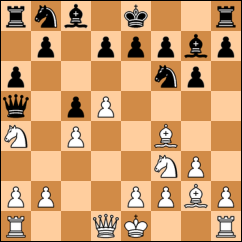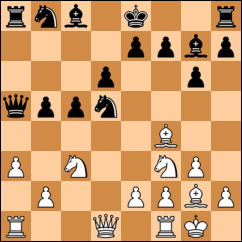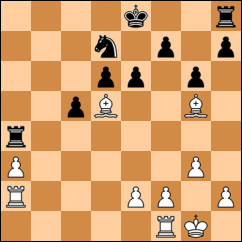That hasn't deterred me from trying to come up with responses that make him stop and go, "Hm." These have revolved around the moves 1...e5, 2...Nf6 and 3...c6, with the intent of blunting the power of the fianchettoed bishop down the long diagonal. But this week, feeling the need for some variety, I opted for a symmetrical response.
W. Koester–K. Ammann
Route 20 Chess Club
Freeport, Illinois, Sept. 15, 2009
1.c4 c5 2.g3!? g6 3.Bg2 Bg7 4.Nf3 Nf6 5.Nc3 Nc6 6.d4 Qa5
The book response to 6.d4 is either 6...cxd4 or 6...0-0, but I was concerned that I would come out behind if I initiated an exchange. However, Fritz calls the exchanged position even, while my move affords white a slim advantage.
7.d5 Nb8 8.Bd2 a6
I didn't want that knight coming in on b5. But Fritz prefers d6, corking white's pawn, which could rip away my king's protection if it advanced first.
9.Na4 Qc7 10.Bf4 Qa5+
The position has evened up. Now Bill and I do a little dance in which I basically dare him to draw by repetition:
11.Bd2 Qc7 12.Bf4 12.Qa5+ 13.Nc3
Bill decides he doesn't like to dance.
13...d6
Better late than never.
14.0-0 b5
Starting to gain some real space on the queenside.
15.cxb5 axb5 16.a3 Nxd5??
Gott in Himmel, what am I doing? It's moves like this that keep my rating in the triple digits. The best justification I can offer is that I wanted to open up the long diagonal in order to bring my own fianchettoed bishop into the attack. Fritz says I should have just castled.
17.Nxd5
Now Bill has a solid lead.
17...Bxb2
This move made Bill do a little double-take, but in the end, it lost me a tempo. I would have been better off redeploying my backward knight.
18.Ra2
Fritz prefers sending a nastygram with 18.Nxe7. If I take the rook, black recaptures with 19.Qxa1, threatening 20.Qxh8+; even if I play 19...Kxe7, 20.Qxh8 leaves me no better off materially than I was before, plus my position resembles a camp of lazy, disorganized Cub Scouts, while his is a legionnaires' fortress. If I immediately nab the knight with 18...Kxe7, 19.Qxd6+ is an Excedrin headache. Bill's actual move lets me off the hook somewhat.
18...Bg7 19.Ng5
19.Nxe7 was still a possibility.
19...Bb7?
19...Ra7 would have snuffed the possibility of 20.Nxe7 out. But 19...Bb7 is bad for another reason, which will become apparent in a moment.
20.Bd2
Bill clearly doesn't see how much trouble 20.Nxe7 will cause me and chooses to harass my queen instead.
20...Qd8 21.Nf6+
Bill seizes a tactical opportunity: Since I've left my rook in the corner, 21.Nf6+ discovers a threat along the diagonal, and I lose another piece. At least it was the bishop and not the rook.
21...Bxf6 22.Bxb7 Ra4 23.Bd5
23.Qb3!? would have been even more hurtful, putting pressure on both f7 and b5.
23...e6 Qb3
With the f7 pawn now shielded and his bishop under attack, it's too late for bill to play Qb3; 24.Bb3 was better, saving the piece while threatening my rook.
24....Bxg5?
Merry Christmas, Bill! Once again, I should have castled.
25.Qxb5+ Qd7 26.Qxd7
Bill likes to trade queens, so this move was a foregone conclusion -- but in this case, it releases a lot of the pressure against me. 26.Qb2 0-0 27.Bxg5 exd5 28.Rxd5 Kg7 would have kept it up.
26...Nxd7 27.Bxg5??
Greedy Bill! According to Fritz, he threw away his initiative with this move. The way to keep me on the ropes was 27.Bc6, forcing me to choose between losing the exchange (27...Bxd2 28.Bxa4) and losing a bishop without compensation (27...Ra6 28.Bxd7+ Kxd7 29.Bxg5). Instead, I now enjoy a slight advantage!
Now we both flail around a bit before regaining our senses.
27...exd5 28.Rb1? (Rd1 was better) 0-0 (h6 was better) 29.Be7 Re8 30.Bxd6 Rea8 31.Rb7 Rxa3??
And there goes the game. Rxd7 was the threat I overlooked. If 31...R8a7, then 32.Rab2 Rxa3, and I maintain equality.
32.Rxa3 Rxa3 33.Rxd7 Ra1+ 34.Kg2 c4 35.Rd8+ Kg7 36.Be5+ 1-0
The crowning indignity. I resigned here.







0 comments:
Post a Comment